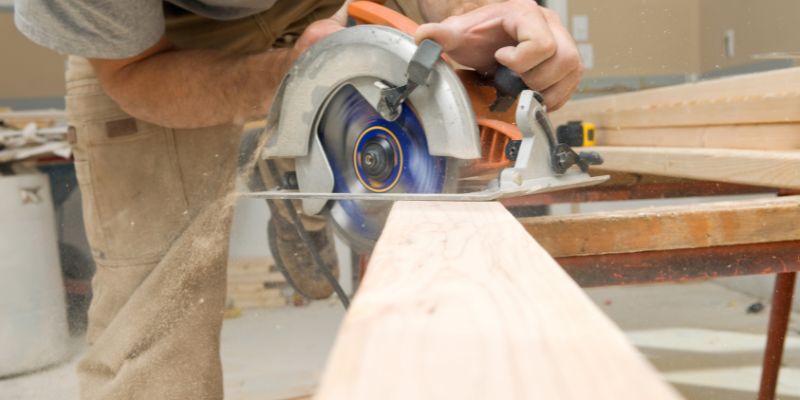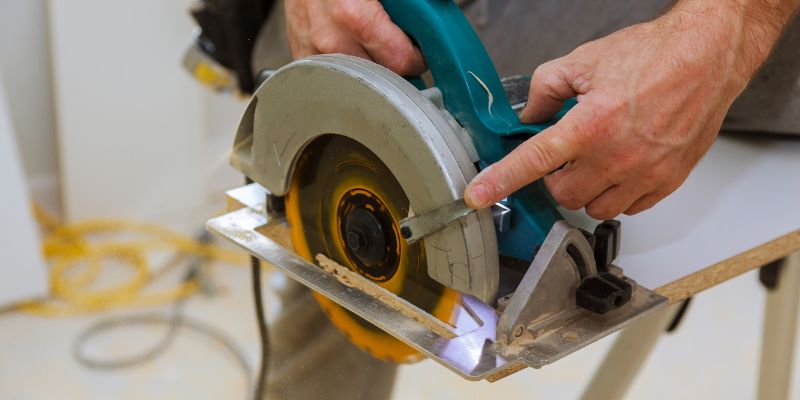To change a circular saw blade for a Craftsman saw, first, disconnect the power source and remove the blade guard. Then, using a wrench, loosen the arbor bolt and take off the old blade.
Upgrading Your Circular Saw Blade For Precision
Upgrade the precision of your circular saw with a step-by-step guide on how to change the blade. Increase accuracy and improve your craftsman skills with a new circular saw blade.
Importance Of Blade Quality In Precision Cutting
When it comes to performing precision cutting tasks with your Craftsman circular saw, the quality of the blade plays a crucial role. Upgrading your circular saw blade can have a significant impact on the accuracy and efficiency of your cutting projects.
Precision cutting requires clean and smooth cuts, whether you’re working on wood, metal, or other materials. And to achieve that level of precision, you need a high-quality circular saw blade that can stand up to the demands of precise cuts.
A blade upgrade can provide you with several benefits:
- Improved cutting accuracy: A sharp and high-quality blade ensures minimal deviation from the cutting line, resulting in precise cuts every time.
- Reduced material waste: With a blade designed for precision cutting, you’ll experience less tear-out and material wastage, saving you time and money on your projects.
- Enhanced cutting speed: Upgrading your blade allows for faster and more efficient cuts, enabling you to complete your projects in less time.
- Extended blade life: Investing in a premium-quality blade means it will last longer, providing you with consistent precision cuts even after multiple uses.
Signs It’s Time For A Blade Upgrade On Craftsman Saws
As a craftsman, it’s essential to stay vigilant and recognize the signs that indicate your circular saw blade may need an upgrade. Continuing to use a worn-out or low-quality blade can compromise the precision and safety of your cutting tasks.
Here are some common signs that it’s time to replace your circular saw blade:
- Blade dullness: If you notice your blade struggling to cut through materials smoothly or leaving behind burn marks, it’s a sign that the blade has become dull and needs replacement.
- Excessive vibration: A blade that causes excessive vibration during operation can indicate wear or damage. This vibration can lead to inaccurate cuts, making it necessary to upgrade your blade.
- Uneven or rough cuts: If you’re experiencing inconsistent or rough cuts, even with proper technique and alignment, it could be a sign that your blade is no longer capable of delivering precise results.
- Warping or bending: Over time, blades can warp or develop bends, affecting the quality of your cuts. A distorted blade should be replaced to ensure precise and safe cutting.
- Inefficiency and slow cutting speed: If you find that your circular saw is struggling to cut through materials as quickly as it used to, it’s likely due to a blade that no longer retains its sharpness. Upgrading your blade can restore efficient cutting performance.
By recognizing these signs and promptly upgrading your circular saw blade, you can ensure that your Craftsman saw remains a reliable tool for achieving precision cuts in your woodworking and DIY projects.

Selecting The Ideal Saw Blade
When it comes to using your Craftsman circular saw effectively, selecting the ideal saw blade is crucial. The right blade can make all the difference in achieving smooth, clean cuts and improving the overall quality of your woodwork projects.
Assessing Material And Project Needs:
Before diving into the selection process, it’s important to assess your material and project needs. Each type of saw blade is designed for specific materials and cutting applications, so understanding your requirements is imperative.
- The type of material you’ll be cutting, whether it’s wood, metal, or composite materials.
- The thickness of the material.
- The desired type of cut, such as crosscuts or rip cuts.
- The level of precision and finish needed for your project.
Understanding Tooth Count And Blade Types For Craftsman Saws:
The tooth count and blade type are essential considerations when selecting a saw blade for your Craftsman circular saw. The tooth count determines the roughness or smoothness of the cut and the blade types cater to various cutting applications.
The tooth count typically varies between 18 and 100 teeth, with higher tooth counts offering smoother cuts for fine woodworking projects and lower tooth counts providing faster, rougher cuts for rough carpentry or construction work.
- Rip-Cutting Blades: Ideal for cutting along the grain of the wood, these blades typically have fewer teeth and large gullets to efficiently remove material.
- Crosscutting Blades: Designed for cutting across the grain of the wood, these blades have more teeth and are suitable for achieving smooth cuts.
- Combination Blades: As the name suggests, combination blades are versatile and can handle both ripping and crosscutting tasks. They strike a balance between tooth count and tooth design for general-purpose cutting.
- Specialty Blades: These blades cater to specific cutting needs, such as cutting plywood, melamine, metal, or plastic. They are engineered with specialized tooth configurations for better results in specific materials.
Now that you understand the importance of assessing your material and project needs as well as the significance of tooth count and blade types, you can confidently choose the ideal saw blade for your Craftsman circular saw. Remember, selecting the right blade will ensure efficient, precise, and professional-looking cuts for all your woodworking endeavors.
Preparing For The Blade Change
Learn how to change the circular saw blade on your Craftsman tool with these easy steps. Ensure a smooth blade change by following this simple guide.
Safety Procedures To Follow Before Starting
Before attempting to change the circular saw blade on your Craftsman saw, it’s important to prioritize safety. Following these safety procedures will help prevent accidents and ensure a smooth and successful blade change:
- Disconnect the Power: Always disconnect the saw from the power source before beginning any maintenance or blade change. This will eliminate the risk of accidental starting.
- Wear Protective Gear: Put on a pair of safety goggles to protect your eyes from any debris that may arise during the blade change. It’s also recommended to wear gloves to provide added grip and protect your hands.
- Work in a Well-lit Area: Ensure you are working in a well-lit space to have clear visibility of the blade and its components.
- Ensure Stability: Place the saw on a stable work surface before beginning the blade change. This will prevent the saw from moving or tipping over during the process.
- Inspect the Saw: Before starting the blade change, inspect the circular saw for any signs of damage or wear. If you notice any issues, it’s important to address them before proceeding.
Gathering The Necessary Tools And Equipment
Before you begin the blade change, make sure you have all the necessary tools and equipment at hand. Having these items ready will streamline the process and prevent any unnecessary delays:
| Tools and Equipment | Description |
|---|---|
| Allen Wrench | An Allen wrench is required to remove the blade securing bolt. Ensure you have the correct size for your saw. |
| Circular Saw Blade | Have the replacement blade readily available. Make sure it is the correct size and compatible with your Craftsman saw model. |
| Workbench or Stable Surface | A workbench or other stable surface will provide a secure area to work on the saw, reducing the risk of accidents. |
By gathering these tools and equipment beforehand, you’ll be prepared and less likely to encounter any difficulties during the blade change.
Now that you understand the safety procedures and have the necessary tools and equipment, you’re ready to proceed with changing the circular saw blade on your Craftsman saw.
Note:
Please refer to your Craftsman saw’s user manual for specific instructions and guidelines for your model. Always follow the manufacturer’s recommendations for safe usage and maintenance of your power tools.
Mastering The Blade Replacement Process
Mastering the Blade Replacement Process is an essential skill for any craftsman or DIY enthusiast. Whether you need to install a new blade or replace a worn-out one, knowing how to change a circular saw blade can save you time and money. In this guide, we will provide you with a step-by-step process to effortlessly remove the old blade and securely align the new Craftsman circular saw blade. So let’s dive right into it and equip you with the knowledge you need.
Step-by-step Guide To Removing The Old Blade/h3
- Step 1: Before starting the blade replacement process, ensure that the circular saw is powered off and unplugged for safety purposes. Safety should always be your top priority.
- Step 2: Locate the blade lock button on your Craftsman circular saw. It is usually located near the blade housing or the motor. Depress this button to keep the blade from rotating.
- Step 3: Once the blade is locked in place, use a wrench or the provided blade changing tool to loosen the arbor nut that secures the blade. Turn the wrench counterclockwise to remove the nut.
- Step 4: Carefully remove the old circular saw blade from the arbor, ensuring not to touch the sharp edges.
- Step 5: Inspect the arbor and the blade housing for any debris or buildup. Clear away any dirt or sawdust using a brush or compressed air.
Aligning And Securing Your New Craftsman Circular Saw Blade/h3
- Step 1: Before inserting the new blade, make sure it is compatible with your Craftsman circular saw. Check the diameter and the arbor size to ensure a proper fit.
- Step 2: Position the new blade onto the arbor, aligning the center hole of the blade with the arbor shaft.
- Step 3: Once aligned, insert the arbor nut back onto the arbor and tighten it with the wrench or blade changing tool. Turn the wrench clockwise this time to securely fasten the nut.
- Step 4: Ensure that the blade is firmly attached by giving it a gentle tug. It should not move or wobble.
- Step 5: Finally, double-check that the blade lock button is released, allowing the blade to rotate freely. Your new Craftsman circular saw blade is now successfully installed and ready for use.
Remember to always follow proper safety precautions when working with power tools. Now that you’ve mastered the blade replacement process, you can confidently tackle any woodworking or construction project with a sharp and reliable Craftsman circular saw blade.
Ensuring Optimal Performance Post-upgrade
Learn how to change a circular saw blade Craftsman to ensure optimal performance post-upgrade. Follow these step-by-step instructions for a smooth and efficient blade replacement process.
When it comes to changing a circular saw blade on your Craftsman tool, the process itself is relatively straightforward. However, ensuring optimal performance after the upgrade requires a few additional steps. By making adjustments and calibrations for precision and following maintenance tips for your upgraded Craftsman circular saw blade, you can maximize its lifespan and cutting efficiency.
Adjustments And Calibrations For Precision
To guarantee precise and accurate cuts, it is crucial to make the necessary adjustments and calibrations after changing the circular saw blade. Here are the steps to follow:
1. Check the Blade Alignment: Before you start using the saw, inspect the position of the blade in relation to the saw’s base or shoe. Ensure that the blade is parallel to the shoe and that there is no misalignment, as this could result in improper cuts and potential safety hazards.
2. Adjust the Cutting Depth: Depending on the nature of your project, you may need to change the cutting depth. By adjusting the depth setting on your Craftsman circular saw, you can ensure that the blade penetrates the material just the right amount, preventing both insufficient and excessive cuts.
3. Fine-Tune the Bevel Angle: If your project requires angled cuts, it is essential to adjust the bevel angle of the saw. Craftsman circular saws typically have a bevel adjustment feature that allows you to tilt the blade to a specific angle, usually up to 45 degrees. By aligning the blade accurately, you can achieve the desired bevel cut.
Maintenance Tips For Your Upgraded Craftsman Circular Saw Blade
Proper maintenance is key to keeping your upgraded Craftsman circular saw blade in optimal condition. By following these maintenance tips, you can ensure longevity and consistent performance:
1. Keep the Blade Clean: After each use, ensure that you thoroughly clean the circular saw blade. Remove any debris or sawdust buildup that may have accumulated during cutting. Wipe the blade with a clean, lint-free cloth, and use a brush or compressed air to reach more stubborn areas.
2. Lubricate Regularly: Applying a small amount of lubricating oil to the blade’s teeth and arbor can significantly reduce friction and prevent overheating. This simple step can extend the blade’s lifespan and improve its cutting efficiency.
3. Inspect for Damage: Routinely inspect your Craftsman circular saw blade for any signs of damage, such as missing or chipped teeth. If you notice any issues, replace the blade immediately to maintain safe and effective cutting performance.
4. Store Properly: When not in use, store your circular saw and blade in a suitable location. Ideally, keep them in a dry area, away from excessive moisture or extreme temperatures. Protect the blade from any potential impact or contact with other tools to prevent nicks or damage.
By making these adjustments and following these maintenance tips, you can ensure that your upgraded Craftsman circular saw blade remains in peak condition, delivering precise and efficient cuts for years to come.

Frequently Asked Questions On How To Change A Circular Saw Blade Craftsman
How Do You Change A Circular Saw Blade On A Craftsman Tool?
To change the circular saw blade on a Craftsman tool, follow these simple steps:
1. Unplug the saw and ensure the blade guard is closed. 2. Using a wrench, loosen the arbor nut holding the blade in place. 3. Remove the old blade and insert the new one, making sure the teeth face in the right direction. 4. Tighten the arbor nut securely. 5. Double-check that the blade is aligned properly and the guard is working before using the saw again.
What Size Blade Does A Craftsman Circular Saw Use?
Craftsman circular saws typically use blades with a diameter of 7-1/4 inches. This is the standard size for most circular saws on the market, and it allows for a good balance between cutting depth and maneuverability. Always check the manufacturer’s specifications for your specific Craftsman model to ensure you are using the correct size blade.
Can I Use A Different Brand Of Blade With My Craftsman Circular Saw?
Yes, you can use a different brand of circular saw blade with your Craftsman saw, as long as it matches the size and specifications recommended by the manufacturer. It’s important to use blades that are specifically designed for circular saws and that they are compatible with your model.
Check the product manual or consult with a professional if you’re uncertain about blade compatibility.
Conclusion
Changing a circular saw blade can be a simple and necessary task for any craftsman. By following the step-by-step guide provided in this blog post, you can confidently replace your circular saw blade and ensure the smooth and efficient operation of your tool.
Remember to prioritize safety precautions and consult the manufacturer’s instructions for any specific details. With this knowledge, you’ll be prepared to tackle any project with your circular saw. Happy sawing!


